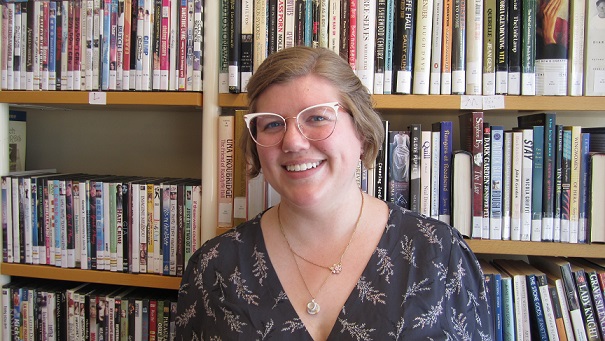By Fan-Ling Suen
The city of Guelph is a cultural landscape – steeped in rich history, old stories, and architectural heritage. Many of us may not know the origins or layered histories behind our community, but learning the stories that shape our city can inform our present relationship to our communities, offer new perspectives within our neighbourhoods, and create a stronger connection to the spaces and places we call home as Guelphites. Even though cultural history is a collection of narratives, it’s also personal. So we interviewed Kesia Kvill, Guelph Arts Council’s Historical Walking Tour Guide, a local Guelphite, and PhD candidate in Canadian history to give us her scoop on Guelph’s history.
Kesia Kvill, Guelph Arts Council Historical Walking Tour Guide and PhD candidate in Canadian and food history
Q. As a PhD candidate, you’ve chosen to specialize in Canadian and food history with broad interest in topics related to cultural, women’s, and domestic history. From this lens and perspective, what do you wish other people knew about Guelph?
A. I think that it’s really important that we think about how central women were to the city of Guelph as members of the community. Women were heavily involved in community-based organizations and efforts in Guelph, like the Imperial Order of the Daughters of the Empire and the Women’s Institutes. These organizations played an important role in drawing attention to poverty, public health, and women’s rights. Guelph has a real history of building cultural spaces, like the Opera House and Skating Rink, through public subscription; women’s fundraising efforts through things like teas and bake sales would have been essential to the success of these.
I also think it’s really important that we talk about the women and children who came to Guelph with their husbands and fathers. Guelph’s founders were not just men. This is particularly important when we talk about the historic houses that are so important to the character of our city. Often, we talk about the men that houses (and buildings in general) were built for or by and we forget that these were homes for families. Women were the ones in charge of creating and managing homes and are just as important, and maybe more so, to how they looked. With the buildings we feature on our tours, particularly the Downtown Walkabout, I think it’s also important that we consider how women worked and shopped in various businesses and were also essential for the financial success of a growing city.
-
 With an interest in Canadian history and food, Kesia sometimes bakes cookies following old recipes.
With an interest in Canadian history and food, Kesia sometimes bakes cookies following old recipes.
These buckwheat cookies were baked from a recipe that dates back to 1918!
Q. What initially interested you in becoming a Historical Walking Tour Guide for the Guelph Arts Council?
A. A big reason I wanted to become a Historic Walking Tour Guide is that I wanted to learn more about the place I was living in. I feel more at home and connected with a place when I know its history. I also had previous experience as a tour guide and really wanted to get involved in my new community, and the GAC walking tours seemed like a perfect way to learn more about Guelph and form community.
For over 30 years, Guelph Arts Council has promoted the cultural heritage of Guelph by offering six different walking tours on selected Sundays from April to October. Re-discover Guelph through a historical lens and join historian Kesia Kvill on her tour Sunday, Aug 18 at Brooklyn and the College Hill. Tickets for all tours are available through Eventbrite. Curious to learn more about Canadian and food history? Read Kesia’s blog at potatoesrhubarbandox.wordpress.com








